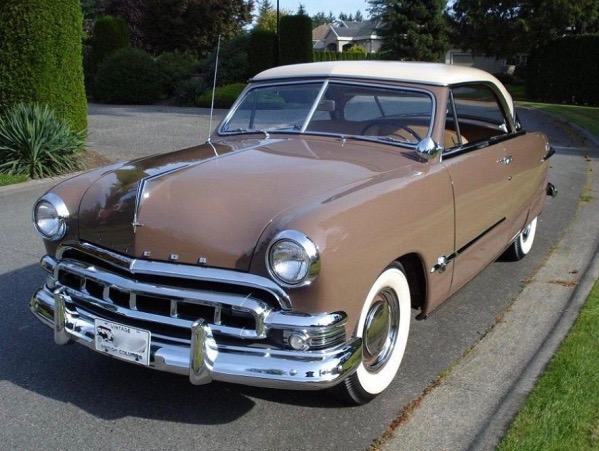Two-tone paint jobs were around long before the 1950s. Before "streamlining" and envelope bodies came on line, two-toning often took the form of fenders, valances covering the frame, and perhaps some other areas being painted black, the remainder of the body being in another color. By the 1940s, the two-tone convention was that the "greenhouse" -- the part of the body above the "belt line" (roughly at, or just below, the lower edge of the windows) -- would be one color and the rest of the car another.
As noted, in the mid-1950s this convention had been abandoned and marketers were urging stylists to keep up with the competition by creating increasingly baroque color patterns. Unlike nowadays, most brands were based on a single "platform" or basic body. So stylists had what amounted to a single canvas to decorate using various color area patterns.
The present post features 1956 Fords. The Thunderbird and station wagons aside, Ford offered three lines: the entry-level Mainline, the intermediate Customline and the top-level Fairlane. Each had its side color/trim design.
This shows the gamut of 1956 Fords (click to enlarge slightly). The various lines are discussed below.
Top-of-the-line Fairlanes (named after Henry Ford's estate) carried over the 1955 checkmark color division pattern. Proportions were altered and the horizontal segment was made wider with ribbing and other details added. The white or cream color in this illustration covers the hood, trunk and part of the upper sides.
Customline Fords got a different color division design, though the roof and lower body (like the Fairlanes) received one color and the hood, trunk and upper sides another. However another, traditional, color split was offered. The green car at the lower left has a dark green top with the rest of the body painted light green.
Mainline Fords featured a variation of the Customline trim. The upper part of the side trim on the large image above is part of the Customline package. A lower horizontal chromed strip has been added to define an area of color matching that on the car's top. The small images show one-tone paint jobs. On these cars the secondary chromed strip just mentioned is absent.
This is a 1955 Mainline Ford, a bottom-of-the-line car from the previous model year when the two/three tone fad was less intensely followed. Here there is no chromed side trim and the car is pained using only one color.




















































